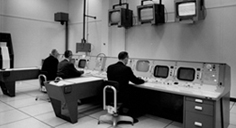Company Milestones
Company MilestonesOur Role in Putting a Man on the Moon
Ford Motor Company's creative imagination extended beyond its automotive operations and, literally, into outer space and onto the moon. For more than 20 years, Ford Aerospace engineers and technicians provided design, construction and operational services for NASA's Mission Control Center near Houston.

Putting a Man On the Moon
In early 1963, our Philco subsidiary was awarded the contract to implement NASA's Mission Control Center at the Manned Spacecraft Center near Houston. In the same year, we transferred our Aeronutronic Division to Philco. Ford Motor Company had put people on wheels; through Philco, we were able to play a central role in the most historic and exciting phase of the American space program.
Ford-Philco engineers unveiled the sophisticated system that became known as "Mission Control" in 1965. Mission Control played a key role in the Gemini and Apollo manned spacecraft exploration programs, including the historic moon landings. It provided centralized mission control of manned spaceflight programs, including full mission control from launch through recovery. The work entailed technical management in the areas of vehicle systems, flight dynamics, life systems, flight crew activities, recovery support and ground network operations.
The project transformed science fiction into reality, because it meant that manned space activities would be conducted with full "Earth Control"—a big leap at the time.
Support Work for Gemini and Apollo
In addition to being the prime contractor for implementation of the Mission Control Center, Philco was doing other support work for NASA during the Gemini and Apollo space programs. Philco supported many defense and space projects during that period because of its capabilities in transistors, solid state devices and microelectronics.
Over the years, Ford Aerospace continued to provide the U.S. Department of Defense and NASA with satellite control systems and ground terminals, which are the basic communication links for space missions. In 1976, it was awarded a $235 million contract to build seven satellites for a 95-nation satellite organization. Many live television transmissions between continents, and many telephone calls, are relayed today by these satellites.
Later Years
By 1986, Ford Aerospace & Communications Corporation was an international leader in satellite communications, high-speed information systems, and communications and environmental satellites.
In October 1990, what was then known as Ford Aerospace Corporation was sold to Loral Corporation for $715 million, ending the company’s involvement in space technology.
Historic Sites

The Rouge
Ford's Rouge Complex is known as an industrial trend-setter in both the 20th and 21st centuries.
Inn on the Tarmac
More than 90 years, the Dearborn Inn was one of the first airport hotels.
Fair Lane: Where The Fords Called "Home"
Henry and Clara Ford's final home, Fair Lane, included a hydroelectric powerhouse and nature areas and is still a landmark today.









